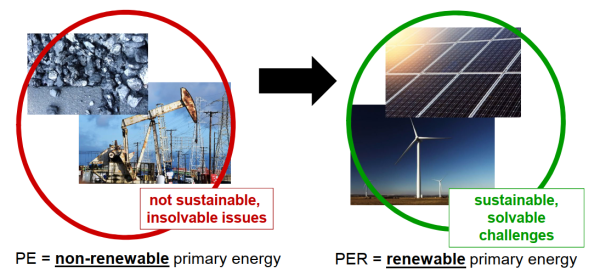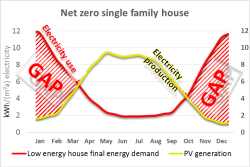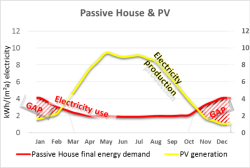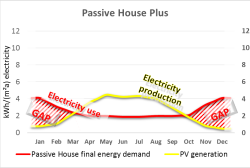Table of Contents
Primary Energy Renewable PER
Welcome to the Primary Energy Renewable (PER) landing page. Here you will be able to find an introduction to the topic of PER and further articles that explain the various aspects of this subject area.
Assessment methods for buildings
Common methodologies for the energy efficiency assessment of buildings are:
- Primary energy (PE) (non-renewable) or
- the greenhouse gas impact, indicated by CO2-equivalent emissions, or the so called Global Warming Potential (GWP).
Presently our main concern is the reduction of greenhouse gas emissions and the transition to a non-fossil-based energy supply, which will take place over several decades. Buildings constructed today will have longer life cycles than just the transition phase to a non-fossil based society and hence they will also be used in the post-transition era. During the transition phase, PE and CO2-equivalent emission factors are changing, and will finally approach zero as we reach a society powered by 100% renewable energy. Does this mean, buildings, regardless of their construction, become better and better and their (final) energy use doesn’t matter?
The above-mentioned assessment methods suggest this, but obviously, this is not the case. Renewable energy must be generated, delivered, and often stored. Renewable energy needs infrastructure and space which will become a decisive limiting factor. We want affordable renewable energy for all, and for all applications. For these reasons, energy use must be efficient: energy efficiency is the prerequisite for effective renewable energy supply. Bearing in mind that a third of the total energy consumed in developed countries is required for operating buildings, we realise how important this sector is for the transition, and obviously the traditional assessment methods are not adequate for this future scenario.
Sustainable buildings for a sustainable future
When our society’s energy supply becomes 100% renewable, we will need guidance on how to design and construct buildings to become an integral part of our renewable future. With the new PER system, an assessment method has been developed which allows the optimisation of buildings with respect to their performance in a system with 100 % of their energy derived from renewable resources. In such a supply system, buildings will play a major role not only by reducing their energy need, but also by providing space and structure for renewable energy generation assets.
Zero, Net zero, Nearly Zero, Plus: Which is the best solution?
Zero, Net Zero, Nearly Zero, Plus: these assessment systems already account for renewables generated on site (or nearby). Here final energy needs or uses are balanced with energy production. But energy demand and renewable energy supply are not synchronized. Therefore, energy must be stored until it is needed, and of course, this requires additional energy which must be considered. Seasonal disparities in energy production and consumption are particularly problematic: Net zero buildings typically require most energy in winter, which must be generated in summer and stored for the winter. This does not only require extra energy, but it is also very expensive since the storage can only be used once a year. Therefore, it is advisable to build more efficient buildings, especially to reduce energy demand in seasons where there is insufficient renewable energy available to address the demand.
What is Primary energy renewable?
Renewable primary energy (PER) is the unit of energy generated from renewable resources, e.g. electricity produced by a photovoltaic system / wind turbine or heat generated with a solar thermal system. PER-factors reflect the primary renewable resources needed to cover the final energy demand of a building, including distribution and storage losses. In the case of a PER-factor of 1.5, a surplus of 50% renewable primary energy is needed to be able to meet the final energy demand at the building. The higher the PER-factor, the higher the required resources and therefore the more important the implementation of efficiency measures in order to avoid compensation from non-renewable sources.
With the PER system, the energy transition to 100 % primary energy supply from renewable resources is anticipated. The new assessment methodology does not promote the simple annual offset of on-site energy demand and energy production in the context of individual buildings. The achieved level of energy efficiency and renewable energy supply need to be assessed independently of one another. Direct offsetting disregards important aspects, such as energy losses due to storage and space availability for renewable energy production.
Within the PER system, the energy demand of buildings is analysed in an environment of a solely renewable energy supply network. Depending on the type of energy application, as well as on the locally available renewable energy resources, the amount of required storage varies, and thus the associated losses. Based on these interrelationships, weighting factors, the so-called PER factors are derived and used as indicator as to which energy applications are the most resource intensive. In this way, PER factors depend only on the location of the building, the application (e.g. heating, cooling or specific electricity), and the final energy carrier. They do not depend on the actual supply system. They are local physical parameters, such as climate data. In practice, they are automatically provided with the PHPP, in the same way the climate data sets are.
PER-factors for electricity use
Passive House – the next decade.
AK56: Primary energy evaluation in a renewable energy supply: the PER system
PER - The assessment for a sustainable energy supply - 1 Page Information for download
Energy use and energy generation
For both energy demand and, if applicable, generation at the building site, the Primary energy renewable is calculated. For the assessment, these have different reference values.
The primary energy renewable demand is measured against the value of the service, which is represented by the useful space of the building, the so-called “Treated floor area (TFA)”.
The primary energy renewable generation is measured against the limited resources which the building possesses, which is the area it occupies, so that it is no longer available for other uses. We call it the “Projected building footprint (PBF)”.
Therefore, the specific PER values for demand and generation cannot be balanced directly and remain as two distinct dimensions of the assessment.

Passive House Classes
The PER assessment methodology is the basis for the definition of the Passive House Classes. They classify the building in terms of their overall efficiency level and the renewable energy production into three distinct categories: Passive House Classic, Plus and Premium.
It is essential to note that the functional definition of the Passive House standard remains unchanged and is the same for all three Passive House classes (relating to useful energy demand for heating and cooling, as well as airtightness and comfort criteria). For the three classes, thresholds for PER demand are defined as well as for PER generation. The demand includes all energy applications in a building i.e. the heating and cooling energy, as well as hot water, the complete electricity demand, and any auxiliary electricity to provide the energy services. The higher the achieved level of overall efficiency and of renewable energy generation, the higher the Passive House class according to the thresholds as listed in Table 1. This makes the Passive House an ideal blueprint for the NZEB standard.
Further articles on Passive House Classes:
The Passive House Classes: Classic, Plus and Premium
The Passive House classes and examples of how they can be reached
Foundation Articles
The following articles are foundation articles which describe the underlying theory, methodology and application of the Primary Energy Renewable system. These articles include the basic knowledge required to understand the PER system and the additional Passive House classes; Passive House Plus and Passive House Premium.
Passive House - The Next Decade
PER-factors for electricity use: Location & application specific decarbonisation
The Passive House Classes: Classic, Plus and Premium
Classic, Plus, Premium: The Passive House classes and how they can be reached
Passive House – On-grid or Off-grid?
Articles on Special Topics
In this section are articles on advanced Primary Energy Renewable topics. These articles go into significant detail on related PER topics and do require an understanding of the basics and foundations of the PER system.
Renewable primary energy demand in residential buildings with high energy intensity
Project-specific primary energy requirements for Passive House Certification
iPHA Fact Sheets and webinars related to PER and Passive House Classes
No. 1: Renewable Primary Energy - the future evaluation system
No. 2: Evaluation of energy generated on or near a building using the PER system
No. 3: The new Passive House Classes based on the PER system and their implications
No. 4: PER, is electricity (still) a "bad" thing?
No. 5: PER Factors - for electricity use
iPHA webinar, April 2022: Assessing sustainability: CO2, PE and PER
Literature and Further Reading
Feist, Wolfgang: Energy concepts – the Passive House in comparison. In: Conference Proceedings of the 17th International Passive House Conference, Frankfurt/Darmstadt 2013.
Feist, Wolfgang: Passive House – the next decade. In: Conference Proceedings of the 18th International Passive House Conference, Aachen/Darmstadt 2014.
Grove-Smith, Jessica and Feist, Wolfgang. The PER assessment method… Conference Proceedings: 19th International Passive House Conference. Innsbruck/Darmstadt, 2015
Grove-Smith, Jessica; Wolfgang Feist; Benjamin Krick: Balancing energy efficiency and renewable energies: An assessment concept for nearly zero-energy buildings. In: Bertoldi, P. JRC of European Commission (ed.): 9th International Conference Improving Energy Efficiency in Commercial Buildings and Smart Communities, 2016. p. 894-902. Link to external article here
Adequate net zero rating approach chosen for case study projects. A report written in context of the outPHit project.
iPHA Blog Bronwyn Barry Our all-renewable energy future: Passive House Plus & Premium
iPHA Affiliate Literature - Passive House and Renewable Energies






